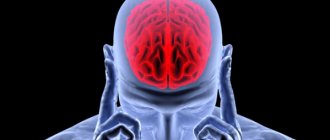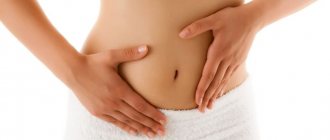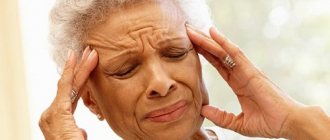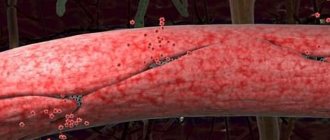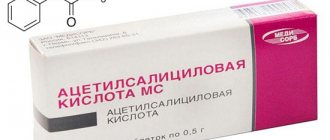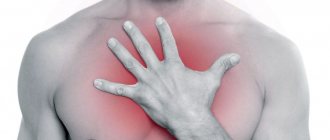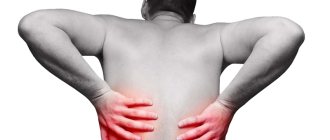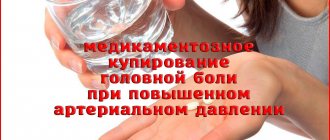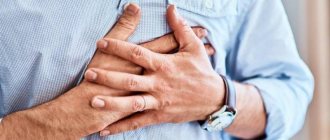Description
The pulsation is accompanied by ringing in the ears, severe dizziness, panic attacks, it appears in the back of the head, in the temples.
The pathological type of pulsation is quite long and constantly repeated. In this situation, you cannot hesitate; you must urgently contact a neurologist. Sometimes unpleasant sensations appear in the vessels of the neck - this indicates arterial hypertension, arrhythmia, or heart disease. What should be done? Urgently undergo an examination to exclude a pathological type of pulsation.
Causes of pulsation of veins in the neck
Ripple may occur during exercise
Pulsation of a vein in the neck after physical exertion, stress or nervous shock is the norm for an absolutely healthy person. But if this sign appears out of the blue, the provocateur is a pathological process.
Main reasons:
- heart failure in the right ventricle, which is accompanied by stagnation of blood (in this case, the vein not only pulsates, but also expands and swells);
- acute pericarditis;
- venous insufficiency;
- arrhythmia;
- hypertension, arterial hypertension;
- atherosclerosis;
- thrombosis of large venous vessels;
- heart disease;
- vegetative-vascular dystonia (VSD);
- emphysema;
- aortic aneurysm, left ventricular aortic stenosis;
- tumors that compress the superior vena cava;
- osteochondrosis of the cervical spine;
- traumatic damage to the vertebrae, ligaments, neck muscles;
- osteomyelitis;
- spondylosis;
- myositis;
- enlarged thyroid gland, goiter (the following signs may indicate these diseases - a lump in the throat, difficulty breathing, painful swallowing of food).
The safest cause of cervical throbbing is an uncomfortable sleeping position. Unpleasant sensations occur immediately after waking up and disappear after warming up the muscles.
Sometimes a child complains of pulsation in the head and neck after suffering from a cold, which occurred against the background of high body temperature. This symptom can be observed with the development of complications - sinusitis, sinusitis, otitis media, tonsillitis.
Enlargement of the jugular vein on the left may indicate heart problems
Pulsation of the jugular vein on the left is a consequence of heart disease (deformity, heart failure, transverse heart block), tricuspid valve insufficiency. Strong pulsation in the neck indicates severe pathological processes. If accompanied by pain, the presence of metastases of malignant neoplasms is likely.
The strength and amplitude of the pulsation of the vein depends on the degree of its filling with blood. The higher the load on the vessel, the stronger the beating, and the more likely the development of complications.
If during examination the pulsation of the carotid arteries on the right and left is different, it is most likely due to an aortic aneurysm, atherosclerosis, or Takayasu’s disease.
Causes
Older people are most susceptible to the disease; sometimes the pathology occurs in young people, but it occurs without symptoms. The exact cause is quite difficult to determine. The specialist conducts a conversation, examines the patient, and then finds out what exactly caused the vascular disorder.
Please note that pulsation in the head area indicates a number of pathologies:
- Damage to vascular walls.
- Autonomic dysfunction.
- Degeneration in the neck - osteochondrosis, hernia, congenital developmental features.
- Aneurysm, vascular malformation.
- Neoplasms of the neck and head.
- ENT pathologies.
- Traumatic brain injury.
- Glaucoma.
- Neurasthenia, neurosis.
- High blood pressure. As a rule, this disease is typical for older people.
When hypertension develops, arterioles and arteries begin to be affected, they become severely spasmed due to high pressure, and subsequently problems with cerebral blood flow arise. Due to the fact that pressure rises sharply, a person experiences a crisis, feels unbearable pain in the back of the head, and is bothered by tinnitus.
Autonomic dysfunction is typical for young people, children, and adolescents. Women are most affected by the disorder. Why? They have impaired regulation of vascular tone, they feel pulsation even in the throat area.
Why does a symptom occur during autonomic dysfunction? It is a consequence of stress, strong emotional experiences, physical exertion, and overwork. Alcohol and smoking have a negative effect.
Various autonomic disorders occur without pain, but additional symptoms may appear:
- The face turns red.
- Body sweating increases.
- Stomach growls.
- I'm worried about cardialgia.
- There is not enough air, breathing quickens.
- Performance decreases.
- The person is weakening.
- A feverish state appears.
- Mood swings.
- Panic attack.
Problems with the spine are typical for modern people who move little, sit constantly, and gain excess weight. Hernias and various vertebral processes are dangerous. In addition, osteochondrosis leads to vascular compression. The pulsation is accompanied by pain in the neck, numbness in the limbs, and pressure surges.
How to get rid
Neck pain radiates to the head, back of the head, and ear - this is a serious symptom that requires a quick response: contacting a specialist, undergoing an examination and selecting an adequate comprehensive treatment.
Painkillers and anti-inflammatory medications
To relieve pain, the patient is prescribed painkillers and anti-inflammatory medications.
Nimesil
Available in powder form for the preparation of a medicinal suspension. Its main component is nimesulide, a substance from the group of non-steroidal anti-inflammatory drugs. Additionally, the following components were introduced into the medication: sucrose, ketomacrogol, citric acid, maltodextrin, orange flavoring.
It is recommended to take it for kidney diseases, osteochondrosis, periarthritis, intervertebral hernias, arthritis. The doctor selects the course and dosage for each patient individually. The medicine is not prescribed for spasms in the bronchi, rhinitis, inflammatory processes in the intestines, liver and kidney failure, bleeding, alcoholism and drug addiction.
Failure to follow the recommendations may provoke the development of undesirable manifestations: decreased vision, headaches, dizziness, shortness of breath, nausea, vomiting, apathy, urination disorder, blood in the urine, signs of hepatitis, gastritis. At the pharmacy, 1 sachet of the drug can be purchased for 30 rubles.
Ibuklin
The drug is available in tablet form and contains 2 active ingredients: ibuprofen and paracetamol. It is thanks to this combination that the drug has analgesic, anti-inflammatory and antipyretic effects. The medication is prescribed for myalgia, neuralgia, back and joint pain, post-traumatic discomfort.
Take 1 tablet up to 3 times a day for no more than 5 days. You cannot prescribe medicine for stomach ulcers, bleeding in the digestive organs, kidney failure, blood ailments, damage to the optic nerve, inflammation of the intestines, children under 12 years of age and women in the 3rd trimester of pregnancy.
Exceeding the dosage is fraught with the development of the following symptoms: nausea, vomiting, headache, nervousness, anxiety, increased blood pressure, anemia, allergic manifestations. The price varies within 100 rubles.
Pregabalin
Pain in the neck that radiates to the head is associated with increased excitability, anxiety, and nervousness, it is recommended to take Pregabalin. The drug is produced in the form of capsules with the active ingredient of the same name. This substance helps contact the voltage-gated calcium channel in the central nervous system, resulting in an analthegic and anticonvulsant effect on the body.
The drug is prescribed for neuropathic pain, anxiety, and fibromyalgia. Take the medicine at 150-600 mg, divided into 3 doses per day. Duration no more than 7 days.
You cannot prescribe the drug for intolerance to the components, hereditary pathologies, galactose and lactase intolerance. Undesirable symptoms include dizziness and drowsiness. Price 250 rub.
Flupirtine
Neck pain radiates to the head and this is due to muscle tension in the neck, then Flupirtine will help. This is a pain reliever available in tablet form. This drug contains flupirtine maleate, due to which the drug has an analgesic, neuroprotective and muscle relaxant effect.
The drug is indicated for painful spasms of the muscles of the musculoskeletal system, headache, post-traumatic discomfort, pain due to oncology. Take the drug 100 mg up to 4 times a day.
The course is individual. You should not take the medicine if you have cholestasis, liver disease, special sensitivity to the composition, myasthenia gravis, lactation, or alcoholism. The average cost of the drug varies within 500 rubles.
Tolperil
For neurological pain, muscle relaxants such as Tolperil are prescribed. The drug is available in tablet form and contains tolperisone hydrochloride as the main component.
This medicine is a centrally acting muscle relaxant, which, when entering the body, inhibits the conduction of impulses of primary afferent fibers and motor neurons, which ultimately leads to blockade of reflexes in the spine and spinal zone.
When does it throb in the neck?
When this symptom appears, you must be extremely careful; it can accompany cardiac or vascular pathology. In this case, severe arrhythmia and headache are observed.
Symptoms especially often accompany aortic aneurysm, thyrotoxicosis, and hypertensive crisis. The problem is typical for older people who have atherosclerosis. It also occurs after syphilis, which affects blood vessels, and rheumatism.
In addition to pulsation, other unpleasant symptoms appear:
- The venous walls in the neck and lower jaw swell.
- When you inhale, the lumen of the veins expands.
- Neck tissues swell.
As a rule, pulsation is most characteristic of heart disease, pericarditis, and pathologies in the lungs (pneumothorax, emphysema).
What to do?
When a patient begins to feel unwell, he immediately panics and develops severe fear. Whatever the reason, you must be examined and consult a doctor. If you have an unpleasant symptom, you need to contact a phlebologist, therapist, neurologist, psychiatrist, endocrinologist, or oncologist. It all depends on the patient's complaints.
The doctor pays attention to several factors:
- When exactly does pulsation occur?
- To what extent is it related to physical and nervous stress?
- Do symptoms appear when the weather changes?
- What else worries you (dizziness, nausea).
The patient must undergo angiography, MRI, ultrasound, Doppler, and X-ray. Additionally, the patient undergoes an ECG.
As for treatment, the doctor prescribes analgesics, vasodilators, and nootropics. In some cases, it is impossible to do without surgical intervention - the aneurysm, tumor are removed, and an artificial heart valve is implanted.
It is very important that the patient adheres to the following recommendations:
- Don’t be nervous, try to avoid various stresses and mental disorders. Often, after severe stress, serious health problems arise, a person’s immune response decreases, he begins to get sick, and various complications appear.
- Don't overwork yourself, relax.
- Eat well.
- Move as much as possible, play sports, sign up for yoga, therapeutic exercises, fitness.
- Carefully monitor your weight, lose extra pounds in a timely manner, it is because of them that many diseases develop.
- Visit the clinic once every six months. For preventive purposes, you need to take tests to monitor your health.
So, when unpleasant symptoms appear, you need to find out the cause and take action as quickly as possible. Be healthy!
Clinical picture
If the veins in the neck are swollen, you need to evaluate the accompanying symptoms and consult a doctor
A vein in the neck may begin to pulsate after stress, physical exertion, and even at rest. More often, the unpleasant symptom goes away on its own and has a short-term effect. Less often, during pulsation, a headache begins, vision deteriorates, spots appear before the eyes, and tinnitus occurs. In such cases, you cannot do without medical help.
Cervical pulsation can be determined by the following signs:
- swelling of the vein during inspiration;
- the pulse in the neck is visible to the naked eye;
- noticeable heartbeat in the anterior chest area;
- swelling of the neck.
Pulsation in the neck may be combined with pulsation in the head. If they are synchronous and coincide with the rhythm of the heart, the cause is cardiovascular pathologies, abnormalities in the structure of blood vessels.
If the pulsation is associated with cervical osteochondrosis, the clinical picture is pronounced. The following symptoms appear:
- dizziness;
- headache;
- pain in the neck area;
- noise in ears;
- spots before the eyes, blurred vision, darkening of the eyes;
- impaired coordination of movements;
- changes in blood pressure;
- nausea;
- loss of consciousness, presyncope.
Pulsation can appear on the left or right side of the neck, radiating to the temples or the back of the head. If it recurs regularly, you need to visit a therapist or neurologist. Isolated cases do not pose a threat.
It is important to learn to distinguish between the pulsation of the carotid artery and the jugular vein. The latter cannot be determined by palpation. However, it is visible to the naked eye. The pulsation is slow, the vein gradually swells from the lower edge of the neck to the angle of the lower jaw, sometimes the sublingual area is affected.
Description
The pulsation is accompanied by ringing in the ears, severe dizziness, panic attacks, it appears in the back of the head, in the temples. The pathological type of pulsation is quite long and constantly repeated. In this situation, you cannot hesitate; you must urgently contact a neurologist.
Sometimes unpleasant sensations appear in the vessels of the neck - this indicates arterial hypertension, arrhythmia, or heart disease. What should be done? Urgently undergo an examination to exclude a pathological type of pulsation.
Consequence of physical activity
Many men and women complain that their neck muscles on the left side hurt. Unpleasant sensations appear the next day after an active workout, going to the gym or performing heavy physical activity. At the same time, the person is bothered by a feeling of numbness in the shoulders and back of the head, and difficulty moving his arms. Why is this happening?
With active muscle contraction, a large amount of lactic acid is formed in them. The cause of pain is irritation of sensitive nerve endings by this substance. Unpleasant symptoms disappear after a couple of days and do not bother the person until the next overload.
Acute pain in the left neck may be caused by the formation of a herniated disc. In this case, painful sensations arise sharply, immediately at the moment of lifting the weight. The patient himself describes them as a “lumbago in the neck.”
Causes
Older people are most susceptible to the disease; sometimes the pathology occurs in young people, but it occurs without symptoms. The exact cause is quite difficult to determine. The specialist conducts a conversation, examines the patient, and then finds out what exactly caused the vascular disorder.
Please note that pulsation in the head area indicates a number of pathologies:
- Damage to vascular walls.
- Autonomic dysfunction.
- Degeneration in the neck - osteochondrosis, hernia, congenital developmental features.
- Aneurysm, vascular malformation.
- Neoplasms of the neck and head.
- ENT pathologies.
- Traumatic brain injury.
- Glaucoma.
- Neurasthenia, neurosis.
- High blood pressure. As a rule, this disease is typical for older people.
When hypertension develops, arterioles and arteries begin to be affected, they become severely spasmed due to high pressure, and subsequently problems with cerebral blood flow arise. Due to the fact that pressure rises sharply, a person experiences a crisis, feels unbearable pain in the back of the head, and is bothered by tinnitus.
Autonomic dysfunction is typical for young people, children, and adolescents. Women are most affected by the disorder. Why? They have impaired regulation of vascular tone, they feel pulsation even in the throat area.
Why does a symptom occur during autonomic dysfunction? It is a consequence of stress, strong emotional experiences, physical exertion, and overwork. Alcohol and smoking have a negative effect.
Various autonomic disorders occur without pain, but additional symptoms may appear:
- The face turns red.
- Body sweating increases.
- Stomach growls.
- I'm worried about cardialgia.
- There is not enough air, breathing quickens.
- Performance decreases.
- The person is weakening.
- A feverish state appears.
- Mood swings.
- Panic attack.
Problems with the spine are typical for modern people who move little, sit constantly, and gain excess weight. Hernias and various vertebral processes are dangerous. In addition, osteochondrosis leads to vascular compression. The pulsation is accompanied by pain in the neck, numbness in the limbs, and pressure surges.
Pain in the back of the head and neck – is it really cervicocranial syndrome?
An unpleasant condition when the head hurts in the back, in the area between the neck and the back of the head, in most cases is caused by a disorder of the cervical spine, i.e.
cervicocranial junction (the area at the back of the head, located between the cervical spine and the skull); Irritation of the cranial nerves is responsible for the occurrence of such an unpleasant condition, in which the back of the head and neck hurt. Sometimes the pressing pain radiates to the sides, as a result of which the shoulders hurt (on the left and right sides), pain in the neck and back of the head shoots into the temples. Irritation causes muscle tension around the cervical spine, unphysiological positioning or tilting of the spine where it meets the skull, and soft tissue swelling (affecting the neck and back of the head) in response to the (often incorrect) loads of the upper body.
As a result, a spasm of the neck muscles occurs, which can occur as a result of a narrowing of the arteries supplying the head. This phenomenon, in turn, can irritate nerve endings in the damaged tissue that transmit pain signals to the brain. Thus, pain occurs (the neck and back of the head hurt), radiating to the sides (shoulders and temples hurt on the left and right sides).
When does it throb in the neck?
When this symptom appears, you must be extremely careful; it can accompany cardiac or vascular pathology. In this case, severe arrhythmia and headache are observed.
Symptoms especially often accompany aortic aneurysm, thyrotoxicosis, and hypertensive crisis. The problem is typical for older people who have atherosclerosis. It also occurs after syphilis, which affects blood vessels, and rheumatism.
In addition to pulsation, other unpleasant symptoms appear:
- The venous walls in the neck and lower jaw swell.
- When you inhale, the lumen of the veins expands.
- Neck tissues swell.
As a rule, pulsation is most characteristic of heart disease, pericarditis, and pathologies in the lungs (pneumothorax, emphysema).
Treatment
The pulsation of the veins in the neck is only a symptom, and not an independent disease, therefore, when identifying the final cause of the symptoms and making a diagnosis, the doctor treats the underlying disease.
When tumors are detected, therapy is aimed at their removal. Heart failure and arrhythmia are treated with lifelong medication. In case of aneurysm, atherosclerosis and some other problems, the doctor may decide to perform an operation, but this practice is used if the vessels are severely pinched or blocked, which interferes with normal blood circulation.
If you notice a throbbing area on your neck once or twice, this does not mean there is a serious danger to your health. But regularly occurring pulsation is a symptom that you should definitely tell your doctor about, even if nothing else bothers you.
Vessels
Brachiocephalic Vein (Left): From Which Veins Is Formed?
Feb 06, 2020 Kokh V. A.
7196
Vessels
Subclavian Vein: Topography, Anatomy, Thrombosis, Puncture
Feb 03, 2020 Kokh V. A.
11245
Vessels
What to do?
When a patient begins to feel unwell, he immediately panics and develops severe fear. Whatever the reason, you must be examined and consult a doctor. If you have an unpleasant symptom, you need to contact a phlebologist, therapist, neurologist, psychiatrist, endocrinologist, or oncologist. It all depends on the patient's complaints.
The doctor pays attention to several factors:
- When exactly does pulsation occur?
- To what extent is it related to physical and nervous stress?
- Do symptoms appear when the weather changes?
- What else worries you (dizziness, nausea).
The patient must undergo angiography, MRI, ultrasound, Doppler, and X-ray. Additionally, the patient undergoes an ECG.
As for treatment, the doctor prescribes analgesics, vasodilators, and nootropics. In some cases, it is impossible to do without surgical intervention - the aneurysm, tumor are removed, and an artificial heart valve is implanted.
It is very important that the patient adheres to the following recommendations:
- Don’t be nervous, try to avoid various stresses and mental disorders. Often, after severe stress, serious health problems arise, a person’s immune response decreases, he begins to get sick, and various complications appear.
- Don't overwork yourself, relax.
- Eat well.
- Move as much as possible, play sports, sign up for yoga, therapeutic exercises, fitness.
- Carefully monitor your weight, lose extra pounds in a timely manner, it is because of them that many diseases develop.
- Visit the clinic once every six months. For preventive purposes, you need to take tests to monitor your health.
So, when unpleasant symptoms appear, you need to find out the cause and take action as quickly as possible. Be healthy!
Something is pulsating on my neck.
Girls, dear, tell me, please! Yesterday I noticed a pulsating vein on my mother's neck. I know that her blood pressure sometimes rises, but still, I’ve never seen anything like this in anyone – the vein just twitches there under the skin. I was really scared for her: what is this?
I don’t know, something below is just twitching like that. What does it mean?
In this section, only neutral information is published in topics and comments. Topics and comments containing advice, recommendations, promotion of alternative methods of treatment or other actions will be closed.
